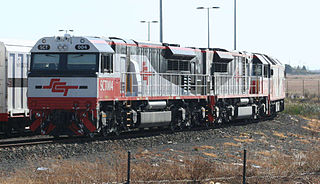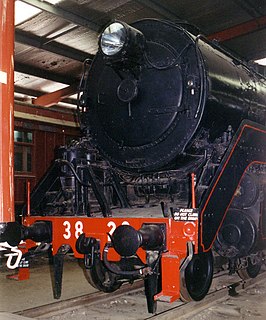
The Lachlan Valley Railway Society is an Australian rail preservation society based in the New South Wales Central Western town of Cowra. It was established in 1974 to preserve and operate former New South Wales Government Railways locomotives and rolling stock. It operates regular heritage train tours to a variety of locations across New South Wales.

The 45 class are a class of diesel-electric locomotives built by AE Goodwin, Auburn for the New South Wales Government Railways between 1962 and 1964.

The 82 class are a class of diesel locomotives built by Clyde Engineering, Braemar for FreightCorp in 1994-1995.
The 90 class are a class of diesel locomotives built by Electro-Motive Division, Canada for FreightCorp and EDi Rail, Cardiff for Pacific National. They only operate on Hunter Valley coal workings because of their heavy weight.

The 422 class are a class of diesel locomotives built by Clyde Engineering, Granville for the Department of Railways New South Wales in 1969/70.

The 421 class are a class of diesel locomotives built by Clyde Engineering, Granville for the Department of Railways New South Wales in 1965/66. These mainline locomotives were a follow on from the 42 class. The 421s retained the classic bulldog nose as with the other Clyde built GM and S locomotives at one end, but featured a flat-cab at the other end. In this respect, they are unique amongst bulldog nose locomotives in the world.

The 47 class are a class of diesel-electric locomotives built by A Goninan & Co for the Public Transport Commission in 1972-1973.

The 48 Class is a class of diesel locomotives built by AE Goodwin, Auburn for the New South Wales Government Railways between 1959 and 1970. Once the most ubiquitous locomotive in New South Wales, Australia, It is based on Alco frames and prime movers, using General Electric electrical equipment. The South Australian Railways 830 and Silverton Rail 48s classes are of a very similar design.

SCT Logistics is an Australian interstate transport company operating rail and road haulage, with facilities in Brisbane, Sydney, Parkes, Melbourne, Adelaide and Perth. The company was founded in 1974.

The 86 class is a class of electric locomotives built by Comeng, Granville for the State Rail Authority of New South Wales.

3820 is a 4-6-2 steam locomotive operated by the New South Wales Government Railways between 1947 and 1970. It has been preserved by the Trainworks Railway Museum, Thirlmere.

The GT46C is a model of diesel electric locomotive designed and built by Clyde Engineering using Electro-Motive Diesel components. Entering service from 1997 for a number of Australian rail freight operators, those built for Westrail are known as the Q class, those for FreightLink are the FQ class and a single unit for Freight Australia is the V class.

The G Class are a class of diesel locomotive built by Clyde Engineering, Rosewater and Somerton for V/Line between 1984 and 1989.

The GT46C ACe is a model of Australian diesel electric locomotive designed and built by Downer Rail at its Cardiff Locomotive Workshops using Electro-Motive Diesel components between 2007 and 2019.

Independent Rail of Australia was an accredited railway freight operator in New South Wales, Australia.

The GT42CU ACe is a model of diesel electric locomotives manufactured by EDi Rail, Maryborough between 2007 and 2013 under licence from Electro-Motive Diesel, for use on narrow gauge railways in Queensland, South Australia and Western Australia.
The AL class are a class of diesel locomotives built by Clyde Engineering, Rosewater for Australian National in 1976-1977. They were mechanically similar to the CL class but instead of a bulldog nose had two flat ended cabs, similar to the 422 class built for the New South Wales Government Railways in 1969.

Preston Workshops is the heavy maintenance facility for the Melbourne tram network. The workshop is located on a block surrounded by Miller Street, St George's Road, Oakover Road and the Mernda railway line in Preston, a suburb of Melbourne, Australia. Following a major redevelopment in April 2016, it also became an operational depot under the name New Preston Depot, taking over from East Preston.

Junee Railway Workshop Pty Ltd ACN 061 696 697 is an accredited rail transport operator and rail infrastructure manager that maintains and repairs locomotives and rolling stock from its base at Junee Locomotive Depot.



















